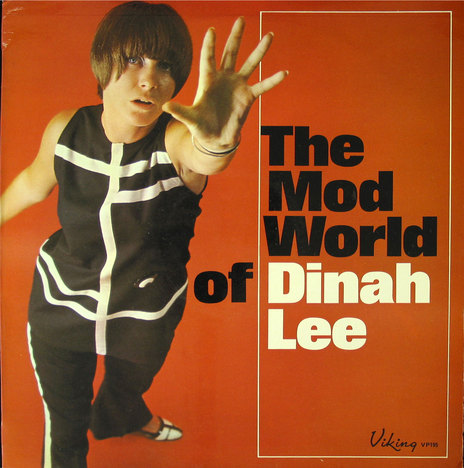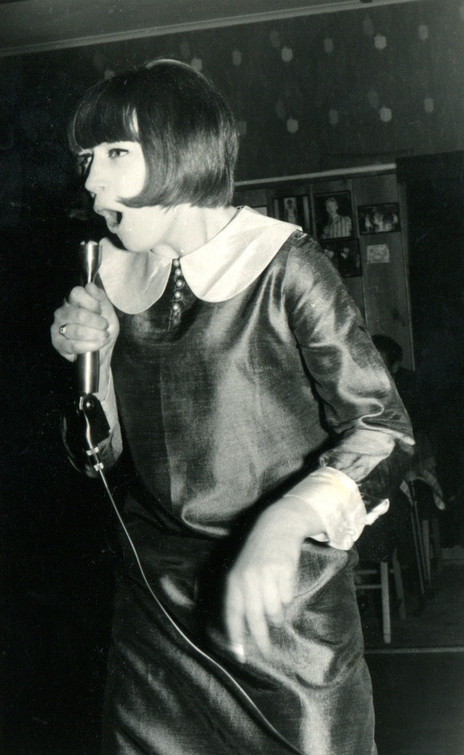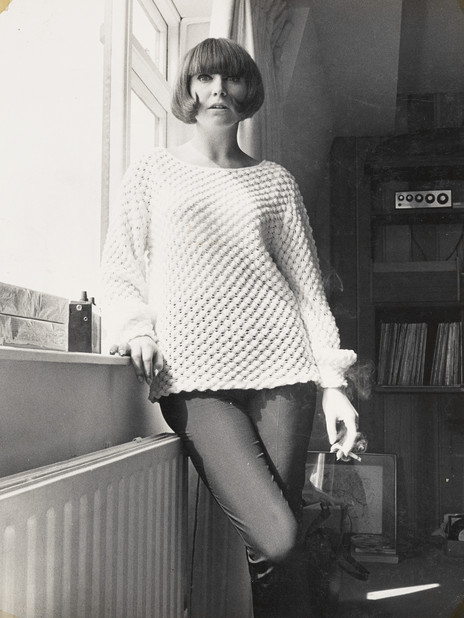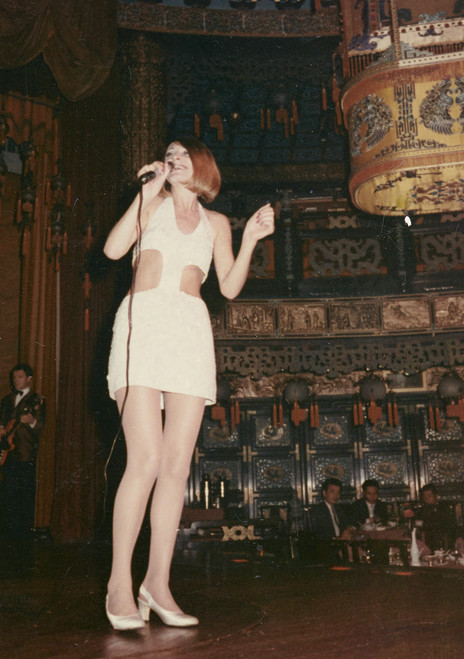Self-decoration to stand out or to fit in has always been part of human nature. War-paint, beads, fabric, tattoo and mask have endured through the millennia as tribal markers or beautification. They’re as prevalent as ever today, making it harder and harder for performing artists to settle on a visual ID that will attract focus above the heads of the crowd.
While some contemporary stars strive to change their entire image head to toe with every new video, song or set in a show, others opt for a particular look. Dinah Lee – aka Queen of the Mods aka the Blue Beat Girl – fitted the latter category, and how she styled herself during her hit-making years of the mid-1960s underlined her persona to such an extent that it is how she is still pictured by many today.

By the start of the 60s, style was the thing. Musical genres were apparent through demarcation zones in dressing – what you wore defined who you were and your affiliations. Earnest harmony groups in polo-necks and goatees, rough-edged protest singers in denims, and delicate sleek-haired female balladeers were folk-music revivalists. Flower-power anti-war hippies preferred psychedelia in both their clothes and music, and jazzmen and women favoured suits and cocktails gowns.
The clean-cut, heartthrob crooners and backcombed beauties of the 50s were largely passé, while out of Britain came the mods and rockers, two opposing subcultures with each faction holding powerful sway over its own followers. The rockers dressed like James Dean or The Wild One-era Marlon Brando – in leathers and studs, and favoured Elvis Presley and 1950s rock ’n’ roll, while mods emulated the latest fashions seen in the international magazines and on the streets of Europe, and listened to the latest in 1960s jazz and R&B.
London and Paris were at the heart of the fashion push, fizzing with change and excitement as catwalk styles influenced and copied street style. Skirts were way up and fringes were way down. Clotheshorses Twiggy, Jean Shrimpton and Penelope Tree modelled the latest Courrèges and Mary Quant garb for the girls, with lots of black-and-white, boxy, mini-dresses with cut-outs or in wide stripes, polka dots or Mondrianesque blocks of colour. Skin-tight white boots were de rigueur, and the look was capped with a Vidal Sassoon chop, pale lipstick, and spiky, doll-like painted-on eyelashes.

Left: Dinah Lee sings after hours at the Pines, Wellington, with Garth Young's band, c1964 - Don Peat
Television came to New Zealand in 1960 and, until the advent of colour TV in late 1973, it was a novel one-channel, black-and-white service. This was the golden age of musical variety shows, both imported and locally made. If performers wanted maximum exposure, television was king and they had to use movement, shapes, gimmicks or textures to stand out against the monochromatic sets. Motown performers strutted, sashayed and sparkled; The Beatles and other pop bands chose uniform hairdos and suits, and new-rockers like the Rolling Stones dressed individually and were shaggier around the edges.
These were the Swinging Sixties and Dinah was among the swingingest, adopting the edgiest looks of the mod scene to accompany her jaunty grooves and quirky-chic style. As a fashion leader, she was influential on both sides of the Tasman and from the earliest days the contemporary press focused as much on her appearance as her music, as a random selection of press coverage shows.
Long after Dinah had moved to Australia in 1965 stories were written about her outfits. Noted were her every couture change, from the short, sharp shock of mod styling to her later floaty garments, swirling patterns and freer, longer hairstyles influenced by the Summer of Love and cabaret styles thereafter.
In the middle of 1965 she released three singles in London – ‘Pushing A Good Thing’, ‘I’m Moving On’ and ‘I Can’t Believe What You Say’ – but apparently just as notable was that she cut her bangs off, into a “switched-on” straight cap à la Mary Quant. The change, she told the NZ Herald at the time, was so she wouldn’t be seen as a Cilla Black clone.

Left: Dinah Lee, 1960s. - Diane Marie Jacobs Collection, Alexander Turnbull Library, Wellington, PA1-f-167-40-1
For her US tour that year the NZ Herald (Oct 1965) reported, “Among the clothes will be several suits, locally made, of the bell-bottom trouser-suit style, in black, gold, green, pink and blue …” and that “the grey-eyed brunette” was switching to cabaret after a short tour of Australia with Johnny O’Keefe. By December, the new “bouffant style created for her in London” was the ’do du jour with her mod fans in Sydney.
A long NZ Herald article in February 1966 wrote up Dinah’s music news, such as her seven-days-a-week Australian nightclub circuit and forthcoming New Zealand tour with West Indian singer Millie (‘My Boy Lollipop’) Small, but the first half of the story focused on her looks. Dinah’s hair, the paper reported, was shorter to match her Jean Shrimpton-type minis that were “all the rage” in Sydney and a change from the singer’s former “ankle-length frocks”. Dinah was quoted as saying that the “hemline inches above the knee was just the thing for Auckland’s humid climate”. It was not until the end of the story that it mentions Gene Pitney was unable to secure a US visa for her, but that her records “have found a market in Japan and South Africa”.
In 1966 and ’67 she undertook concert tours to Vietnam to entertain the young ANZAC soldiers. This accrued more column inches and magazine coverage. The TV Week described in January 1967 what it considered her zany and daring fashions, including culottes in combinations of “vivid greens, oranges and purples”. It also reported that her dressmaker had cut up a Union Jack to make her a trouser suit, which led to murmurings in Australia’s parliament as to whether or not this was desecrating the flag.
In 1967 Dinah was chosen as the face of Yardley of London cosmetics in Australia, because she personified the fashion zeitgeist with her now-longer locks, false eyelashes, minis, overscale accessories and white fishnets.
“What does a queen do when she abdicates?” posed the TV Times in November 1970. Dinah had done the till-then unthinkable: she left her mod image behind by growing out her fringe, let her tresses fade back to their natural brown and dressed in more classic designer fashions. “No longer does she frequent army surplus stores for kinky gear, nor does she turn huge Union Jacks into way-out stage costumes.” The publication was still pursuing this angle the following year, writing about her fringe-free, teased-up, honey-blonde look. “Gone is the Blue Beat girl”, it declared.

Dinah had been living in Sydney for nine years, with no plans to return to New Zealand apart from performance dates. She had matured and moved on considerably from that early impish persona and was well settled in her working life, playing the club circuit, touring and doing floorshows as a sophisticate in her mid-30s.
She had cut her ties from James Haddleton, her former manager, and rocker-showman Johnny O’Keefe had signed her up and was quoted as saying the “pert blonde” will be “one of the busiest thrushes in town”.
In December 1978, the NZ Herald once again focused on her appearance before it mentioned her music:
“Diane James, a tall, solid Christchurch teenager, came to Auckland in the early 1960s and had a haircut. Her heavy fringe and side curls had become the most imitated look in the country by 1964.
“By then she had also modded [sic] up her name to match her new image. Girls asked their hairdressers for ‘Dinah Lee’ cuts. They dressed like Dinah Lee, but no one sang quite like her … swinging her linear torso to the raunchy blue-beat, she earned up to $28,000 a year.”
The write-up continued, saying that she was now a “respected institution” on the Australasian cabaret circuit, and that “inching towards her late 30s, a statuesque glamour has replaced the sassy cuteness of Dinah, circa 1965. No dark fringe or kiss curls – she is a sleek blonde.” (Above: Dinah Lee in Hong Kong, May 1969. - Diane Marie Jacobs Collection, Alexander Turnbull Library, Wellington, PA1-f-167-56-2)
By the 1990s the mod allusion had worn thin, but the press was still mentioning Dinah’s clothes, although more in passing. A newspaper report of 1994, when she had returned to Auckland to play the Wintergarden, noted that was wearing glam-rock outfits such as “culottes of gold and silver-striped lamé richly embroidered with sequins”.
In the same year, in a December story headed “Look What’s Happened to Dinah Lee”, Mary Dunn, of Auckland’s North Shore Gazette, was waiting for Dinah to show up in the hotel lobby for her interview. She was looking for “… the one with the fringe down to her eyelashes and the long, dark bangs that were copied by half the schoolgirls in Auckland.” Instead, she was met by a willowy blonde with a Bondi tan.
And so it will always be. For those short, crazy years during the pop boom in the mid-60s when Dinah Lee topped the charts down under, her look was so characteristic of her songs and stage persona that it not only influenced a generation of Australasian teenage girls, but the “Queen of the Mods” label and associated fashion stylings became convenient and self-perpetuating tags for writers to hang their introductory hooks on whenever writing about her.
Dinah might have taken her style notes from the Northern Hemisphere, but it was her own take on those fashions coupled with her effervescent personality that sold the look. Whether she likes it or not – over 50 years after the title originated – the fact remains, Dinah Lee will always be remembered as our Queen of the Mods.
--